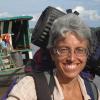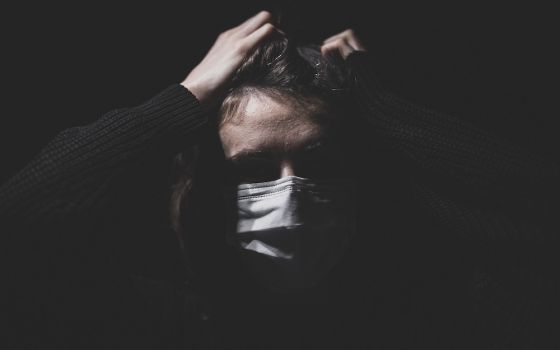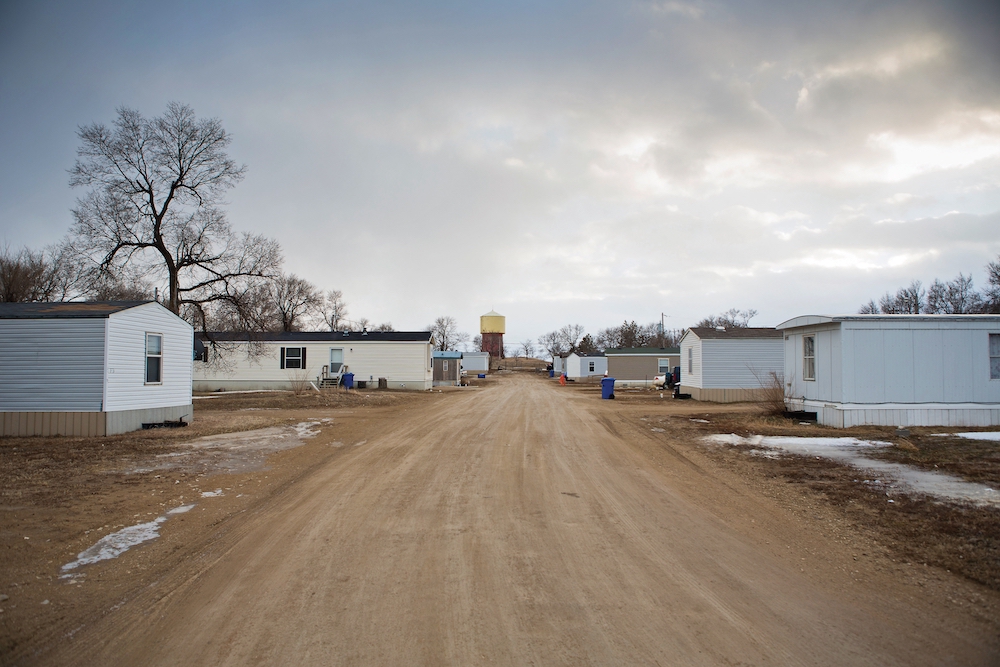
Homes line a dirt road in 2014 on the Rosebud Reservation of the Lakota in south central South Dakota. (CNS/Catholic Extension/Ron Wu)
When word of the novel coronavirus spread through the U.S. a year ago this month, various Native American tribes closed their borders to outsiders in an effort to keep the pandemic at bay. On the Pine Ridge Reservation in South Dakota, Lakota tribal leaders ordered residents to "shelter in place" by staying home, avoiding gatherings and especially protecting elders.
"We knew the vulnerabilities. We know our population," said Tashina Banks Rama, executive vice president of Pine Ridge's Red Cloud Indian School, a Catholic school with Jesuit roots. "And we were terrified that once COVID got here, it was going to be catastrophic to an entire generation."
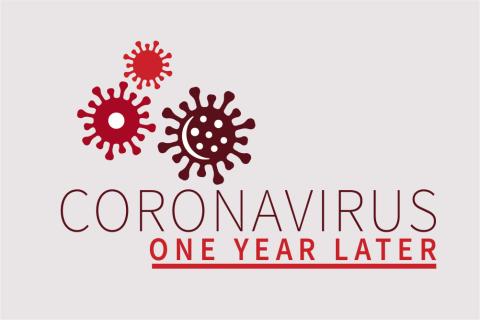
(NCR, GSR logo/Toni-Ann Ortiz)
Despite efforts at isolation, Native Americans have died of COVID-19 at more than twice the rate of white Americans, according to the U.S. Centers for Disease Control and Prevention.
COVID-19 hit hard in communities already suffering from high rates of chronic illnesses, where large families of multiple generations share close quarters and have limited access to safe water and fresh food. Climate change adds to those difficulties, with increasing bouts of extreme weather that threaten residents' safety and health, as well as traditional means of healing.
American Public Media Research Lab's Color of Coronavirus project, which compiles figures from 43 states that report data broken down by ethnic group, recorded 5,477 deaths among Native Americans as of March 2. Although that may seem low compared to total COVID-19 deaths in the U.S., which have eclipsed 520,000, it is the highest per capita death toll of any ethnic group in the country.
Advertisement
The Color of Coronavirus project calculates that for every 100,000 Indigenous people, there have been 256 deaths from COVID-19, compared to 180 for Black Americans, 150 for white people, and 147 for Hispanic and Latino Americans. Other calculations place the figure slightly lower than that of Black Americans, but still far above the death rate for the white population.
At Pine Ridge, the early lockdown helped save lives, but enforced isolation has taken a toll on the community in other ways, Rama, who is Oglala Lakota and Ojibwe, told EarthBeat.
"The impacts of COVID for our community have been detrimental to our economy, but more importantly to the spiritual health of our community members," she said. "A lot of our families were isolated more than they normally are, and they had less access to food than they normally would."
People whose work could not be done remotely lost their jobs, adding to the reservation's already-high unemployment rate. And extended families could not gather for traditional ceremonies, including the funerals of those who died during the pandemic.
"So you had a loss of money, a loss of social interaction, a loss of ceremony — we weren't gathering for sweat or naming ceremonies or birthdays," Rama said. She added that the impact of the isolation "is severe — I say 'is,' because it still is something that our community is working to address with all generations."
On the Pine Ridge Reservation, about 60 people have died of COVID-19, Rama said. That's fewer than in some other communities, but still a large number for the tribe. The communal pain caused by the loss of tribal elders, especially those whose first language was the Indigenous tongue, is particularly acute. The pain of losing family members has been deepened by the inability to grieve in traditional ways, which usually involve ceremonies lasting several days, with extended families sharing meals.
On tribal lands, the pandemic struck communities already battling health problems. Life expectancy among Native American and Alaska Native villagers is 5.5 years less than the U.S. average, and tribal groups have higher rates of heart disease, diabetes and liver disease, according to the National Congress of American Indians.

Cars in Coyote Canyon, New Mexico, on the Navajos' reservation, are seen lined up May 15, 2020, during the coronavirus pandemic. Because of the federal Indian Health System, Native Americans living on tribal lands have better access to COVID-19 vaccines than the 70% of Native Americans who live in urban areas and have trouble accessing IHS services. (CNS/The Republic/USA Today Network, via Reuters/David Wallace)
Public health messages generally stress the important of a healthy diet, but tribal lands are often food deserts, said Nicole Redvers, a member of the Deninu K'ue First Nation in Canada and a professor of family and community medicine at the University of North Dakota, which has a program that encourages young Native Americans to study medicine.
That "definitely sets up our population to be more at risk for diabetes and cardiovascular conditions, which of course may put you in a higher-risk position for things like COVID," she told EarthBeat.
The Pine Ridge Reservation, where around 30,000 people — the figure varies depending on who's counting, Rama said — are scattered across an area a little smaller than Connecticut, has no major grocery store. The convenience stores that exist are expensive and generally do not stock food that spoils quickly, said Maka Black Elk, a member of Oglala Lakota Nation and executive director for truth and healing at the Red Cloud Indian School.
Going to the nearest supermarket can mean up to a three-hour round trip, assuming the family has a car and can afford the gas, he said. And buying in bulk, to make the cost worthwhile, is difficult when families lack storage and freezer space.
Although tribes were especially concerned about protecting their elders from COVID-19, young people have suffered significantly during the pandemic, Black Elk said.
"For teenagers and pre-teens, the staying at home, the shelter in place, the virtual schooling has been incredibly difficult," Black Elk said. "The motivation is incredibly low. There's just a real despair that I think sort of [hangs] over that age group across the reservation."
There also appears to have been "an increase in teenage suicide attempts and successes," possibly because, with schools closed, young people had nowhere to go to escape abusive family situations, he said.
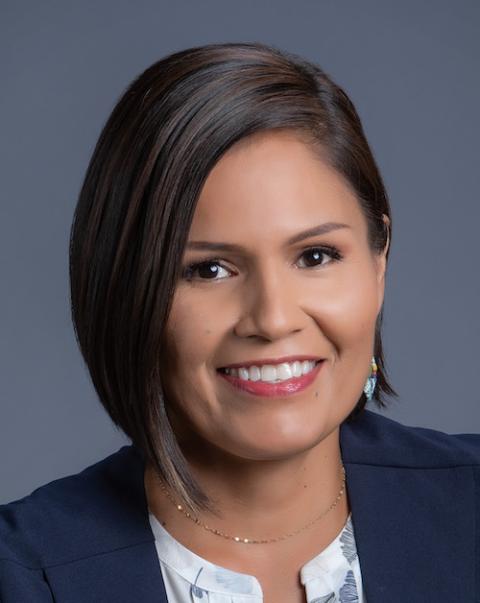
Tashina Banks Rama, executive vice president of Pine Ridge's Red Cloud Indian School. (Provided)
The youth suicide rate is higher for Native Americans than any other demographic group in the U.S. and 2.5 times the national average, according to the National Congress of American Indians.
Another factor affecting health on tribal lands is changing weather patterns, at least some of which are probably linked to climate change.
In the Southwest, Redvers said, elders say that drought makes it harder to find the medicinal plants they traditionally use. And in the Arctic and sub-Arctic regions where she grew up, caribou populations are declining.
"Up north, a caribou is used for so many different purposes, not just for food, but for tools and for ceremony and for other things. So when that gets removed, a huge part of the culture goes with it," she said, adding that the loss has spurred some communities to take a stand against oil drilling in Alaska or demand protection of caribou calving grounds.
And on the historically dry Pine Ridge Reservation, record rainfall in recent years has damaged or destroyed homes in an area that already has a chronic housing shortage, making people even more vulnerable to health problems, Black Elk said.
Amid the health concerns, the coronavirus vaccine has been a bright spot. Vaccination rates on some tribal lands are running ahead of state averages, and many tribal communities are prioritizing vaccination of elders who speak their Indigenous tongue as a first language.
Redvers hopes the pandemic will spur greater government investment in public health infrastructure and preventive healthcare "to ensure that the next time this happens — because it likely will —we have better preparedness overall."
But COVID-19's most important lesson, she added, is for the "the greater world."
"I've heard from many elders that [they] knew a great sickness was coming, because Mother Earth was at her limit and there needed to be a rebalancing … because of the way that we've been treating her, with climate [change] and destruction, ecosystem disruption or resource extraction," Redvers told EarthBeat.
"So what I have heard most often from communities is the hope that the greater world will start to appreciate the importance of taking care of the Earth."
